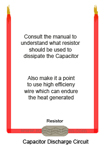Caution:
Capacitors are dangerous beasts. A proper precaution is strictly recommended to avoid lethal accidents. This tutorial tells you again and again to be careful because capacitors are too dangerous if you abuse them.
Charging & Discharging a Capacitor
Charging a capacitor is straight forward. Connect the power source to capacitor leads and if required through a resistor. As a thumb rule, never attempt to connect a capacitor to voltage higher than its breakdown voltage, or working voltage, where breakdown voltage is the voltage up to which dielectric acts as an insulator. If it exceeds, the dielectric starts conducting and shorts. As explicated above, better practice is to consider a capacitor with breakdown voltage at least twice the supply voltage.
Discharging a capacitor is as, or more important than charging. Capacitors hold electric charge even after disconnecting them from the power source; for seconds to minutes to days. For any reason if you need to disassemble them from the circuit, take proper precaution to discharge them to avoid accidental electrocution. If you ever check the back side of your CRT TV, they have an understandable warning printed on them to be cautious before attempting to disassemble it. One of the major concern in the television is a nasty(?) high voltage capacitor which hold charge even after a week of unplugging your TV from mains. If proper care is not taken while discharging them, they can throw you across the room. So better be prepared, or reach a technician who can handle it.
Discharging is neutralizing charge on both the plates by providing a conducting path to the capacitor. Capacitors do not consume power, but just draws energy from source and stores it. When discharged, they throw out whatever stored almost instantly which is why it tends to be dangerous.
 If you have a small capacitor (which holds very less charge), then discharging that is as simple as shorting the leads of capacitor with a screwdriver which gives out a spark and discharges completely; make sure the screwdriver handle is insulated. Although this is a common technique used across, is not a recommended way as it gives out sparks and can damage the circuit under it, or even lead to an injury.
If you have a small capacitor (which holds very less charge), then discharging that is as simple as shorting the leads of capacitor with a screwdriver which gives out a spark and discharges completely; make sure the screwdriver handle is insulated. Although this is a common technique used across, is not a recommended way as it gives out sparks and can damage the circuit under it, or even lead to an injury.
For bigger capacitors however, use a high wattage resistor (also known as Bleeder resistor) connected to a wire on both ends and connect this to capacitor leads. This might take a few seconds and the capacitor will be discharged completely. You can also connect a light bulb to a capacitor and wait until the bulb goes off.
Summary:
Capacitor tutorial can be summarized as follows:
- Capacitors are electrical components which store electric charge or energy when voltage is applied across them, and continue to hold charge until a path is provided for them to discharge everything in one shot, or until they slowly discharge with time.
- To calculate capacitance of a capacitor, we can use the formula C = Q/V where ‘V’ is voltage applied to a capacitor and ‘Q’ is overall charge in the capacitor
- Capacitors come in different types and sizes and are differentiated based on dielectric area, surface area of plates, distance between the plates and dielectric material used
- Most capacitors (larger) have their value printed on them; if in any case it is not available, then Capacitor codes can help you identify the same. Few capacitors also use resistor like color coding to represent its value
- Capacitors can be either connected in series, or in parallel. Connecting capacitors in series reduces the overall capacitance while connecting them in parallel increases overall capacitance
- Since capacitors take time to charge and discharge, they can be used as timing devices
- All and above, proper care should be taken while handling capacitors; It can be either while charging them, or discharging them
Lastly, if you feel this tutorial has helped you, or if you have any queries then write in the forum and also help others by sharing your experience.
Tutorial index:
Do you have anything to say?
Visit the Forum to discuss, learn and share anything related to robotics and electronics !!








